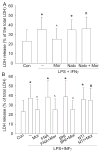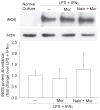Morphine preconditioning reduces lipopolysaccharide and interferon-gamma-induced mouse microglial cell injury via delta 1 opioid receptor activation
- PMID: 20156527
- PMCID: PMC2849923
- DOI: 10.1016/j.neuroscience.2010.02.017
Morphine preconditioning reduces lipopolysaccharide and interferon-gamma-induced mouse microglial cell injury via delta 1 opioid receptor activation
Abstract
Microglial cells play an important role in the inflammatory response of a broad range of brain diseases including stroke, brain infection and neurodegenerative diseases. However, there is very little information regarding how to protect microglial cells. Here, we showed that incubation of the C8-B4 mouse microglial cells with lipopolysaccharide (LPS) plus interferon-gamma (IFN gamma) induced cytotoxicity as assessed by the amount of lactate dehydrogenase (LDH) released from the cells. Preconditioning the cells with morphine for 30 min concentration-dependently reduced LPS plus IFN gamma-induced cell injury. This morphine preconditioning effect was abolished by naloxone, a general opioid receptor antagonist, by naltrindole, a selective delta opioid receptor antagonist and by 7-benzylidenenaltrexone maleate, a selective delta(1) opioid receptor antagonist. However, this protective effect was not affected by beta-funaltrexamine, a selective mu opioid receptor antagonist, nor-binaltorphimine, a selective kappa opioid receptor antagonist or naltriben, a selective delta(2) opioid receptor antagonist. LPS plus IFN gamma induced the expression of inducible nitric oxide synthase (iNOS), which was not affected by morphine preconditioning. Our results suggest that morphine induced a preconditioning effect in microglial cells. This effect may be mediated by delta 1 opioid receptors and may not be through inhibiting the expression of iNOS, a potentially harmful protein.
(c) 2010 IBRO. Published by Elsevier Ltd. All rights reserved.
Figures




Similar articles
-
Morphine reduces mouse microglial engulfment induced by lipopolysaccharide and interferon-γ via δ opioid receptor and p38 mitogen-activated protein kinase.Neurol Res. 2018 Jul;40(7):600-606. doi: 10.1080/01616412.2018.1455368. Epub 2018 Mar 27. Neurol Res. 2018. PMID: 29583107 Free PMC article.
-
Isoflurane preconditioning reduces mouse microglial activation and injury induced by lipopolysaccharide and interferon-gamma.Neuroscience. 2008 Jun 26;154(3):1002-8. doi: 10.1016/j.neuroscience.2008.04.013. Epub 2008 Apr 16. Neuroscience. 2008. PMID: 18495358 Free PMC article.
-
Morphine preconditions Purkinje cells against cell death under in vitro simulated ischemia-reperfusion conditions.Anesthesiology. 2004 Mar;100(3):562-8. doi: 10.1097/00000542-200403000-00015. Anesthesiology. 2004. PMID: 15108969
-
Functional effects of systemically administered agonists and antagonists of mu, delta, and kappa opioid receptor subtypes on body temperature in mice.J Pharmacol Exp Ther. 2002 Sep;302(3):1253-64. doi: 10.1124/jpet.102.037655. J Pharmacol Exp Ther. 2002. PMID: 12183687
-
Investigation of the Effects of Opioids on Microglial Nitrite and Nitric Oxide Synthase (iNOS) Production and Phagocytosis during Inflammation.Comb Chem High Throughput Screen. 2023;26(10):1900-1906. doi: 10.2174/1386207326666221111093915. Comb Chem High Throughput Screen. 2023. PMID: 36372918
Cited by
-
Neuroprotection against hypoxia/ischemia: δ-opioid receptor-mediated cellular/molecular events.Cell Mol Life Sci. 2013 Jul;70(13):2291-303. doi: 10.1007/s00018-012-1167-2. Epub 2012 Sep 27. Cell Mol Life Sci. 2013. PMID: 23014992 Free PMC article. Review.
-
Effect of δ-opioid receptor activation on BDNF-TrkB vs. TNF-α in the mouse cortex exposed to prolonged hypoxia.Int J Mol Sci. 2013 Jul 31;14(8):15959-76. doi: 10.3390/ijms140815959. Int J Mol Sci. 2013. PMID: 23912236 Free PMC article.
-
DOR activation inhibits anoxic/ischemic Na+ influx through Na+ channels via PKC mechanisms in the cortex.Exp Neurol. 2012 Aug;236(2):228-39. doi: 10.1016/j.expneurol.2012.05.006. Epub 2012 May 15. Exp Neurol. 2012. PMID: 22609332 Free PMC article.
-
Opioids Alleviate Oxidative Stress via the Nrf2/HO-1 Pathway in LPS-Stimulated Microglia.Int J Mol Sci. 2023 Jul 4;24(13):11089. doi: 10.3390/ijms241311089. Int J Mol Sci. 2023. PMID: 37446267 Free PMC article.
-
Morphine preconditioning protects against LPS-induced neuroinflammation and memory deficit.J Mol Neurosci. 2012 Sep;48(1):22-34. doi: 10.1007/s12031-012-9726-4. Epub 2012 Mar 3. J Mol Neurosci. 2012. PMID: 22388653
References
-
- Ammon-Treiber S, Stolze D, Schroder H, Loh H, Hollt V. Effects of opioid antagonists and morphine in a hippocampal hypoxia/hypoglycemia model. Neuropharmacology. 2005;49:1160–1169. - PubMed
-
- Barry U, Zuo Z. Opioids: Old drugs for potential new applications. Curr Pharm Des. 2005;11:1343–1350. - PubMed
-
- Brown GC, Bal-Price A. Inflammatory neurodegeneration mediated by nitric oxide, glutamate, and mitochondria. Mol Neurobiol. 2003;27:325–355. - PubMed
Publication types
MeSH terms
Substances
Grants and funding
LinkOut - more resources
Full Text Sources
Research Materials

